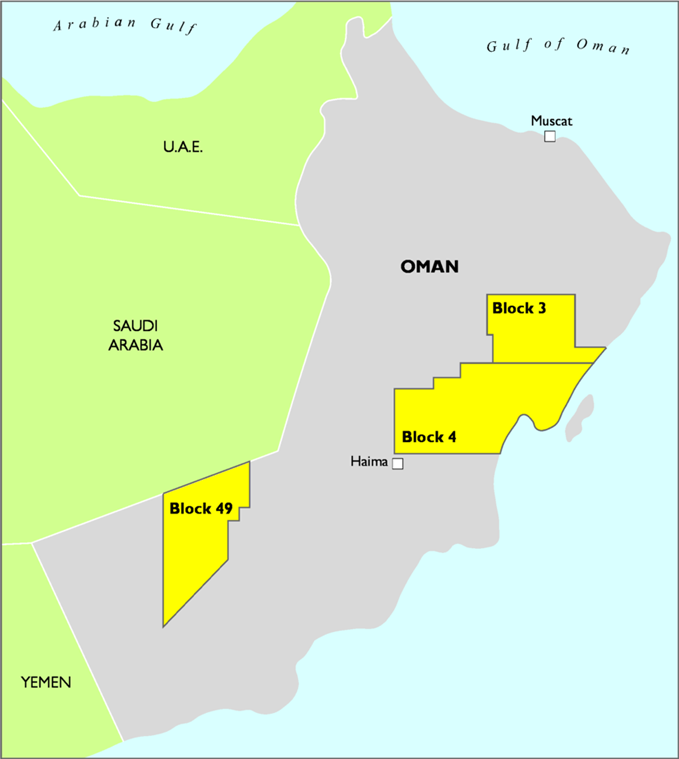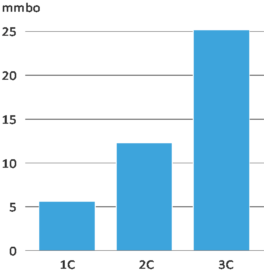Founded in 2001, Tethys Oil is a Swedish oil company with focus on onshore areas with known oil discoveries. Tethys Oil's core area is Oman, where the company holds 2P Reserves of 25 mmbo and 2C Contingent Resources of 13 mmbo and had an average oil production of 11,767 barrels per day from Blocks 3&4 during 2018. Tethys Oil also has onshore exploration licences in Lithuania and France and some production in Lithuania.

Map source: KeyFacts Energy
Tethys Oil acquired an interest in Blocks 3&4 in 2007 and, together with the other partners in the licence interest, initiated oil production on the blocks three years later. From August 2010 through to year-end 2018, Tethys Oil’s net production from Blocks 3&4, before government take, has amounted to about 23 million barrels, while annually increasing reserves. The company’s share of the production, before government take, in July 2019 amounted to 397,376 barrels of oil, corresponding to 12,819 barrels of oil per day.
In late 2017, Tethys Oil’s operations in Oman were expanded when Tethys Oil was awarded a licence as operator for the exploration Block 49.
OMAN
The Sultanate of Oman, strategically located in the southeastern part of the Arabian Peninsula, overlooks the Arabian Sea, the Sea of Oman and the Arabian Gulf. It also overlooks the strategic Strait of Hormuz at the point of entry to the Arabian Gulf. Oman’s neighbours include United Arab Emirates, Saudi Arabia and Yemen.
Oman is a major oil nation, the largest in the Middle East that is not a member of OPEC. Oman has in excess of five billion barrels of estimated proven oil reserves, ranking the country as the 7th largest proved oil reserve holder in the Middle East and the 22nd largest in the world (BP Statistical Review of World Energy, June 2018). Oman’s crude oil and condensate production amounted in 2017 to almost 1 mmbo per day.
The largest producer in Oman is PDO, who holds Block 6, covering an area of 90,874 km² in north, central and south Oman. In 2018, 665,000 barrels of oil and condensate per day were produced by PDO, corresponding to close to 70 percent of the total production in Oman. PDO is owned by the Omani government (60 percent), Shell (34 percent), Total (four percent), and Partex (two percent). Occidental Petroleum (Oxy), is the second-largest producer in Oman, and produced about 200,000 bopd in 2018. Oxy is producing from Blocks 9, 27 and 62 in northern Oman and the Mukhaizna field in Block 53 in the south.
Operations
Tethys Oil acquired an interest in the licence for Blocks 3&4 in 2007. The blocks now cover an area of 29,130 km² in the central eastern part of Oman. Tethys Oil, through its wholly owned subsidiary Tethys Oil Block 3 & 4 Ltd, has a 30 percent interest in Blocks 3&4. Its partners are Mitsui E&P Middle East B.V. with 20 percent and the operator CC Energy Development S.A.L. (Oman branch) holding the remaining 50 percent.
First oil at Farha South: The drilling of the Farha South-3 well on Block 3 in early 2009 was the starting point for the successful exploration and development of Blocks 3&4. Through the Farha South-3 well, the Farha South oil field was discovered, which has been the star performer on the blocks ever since.
Oil on Farha South was originally discovered in 1986 by a previous operator, when the Lower Al Bashir sandstone layer flowed oil. With Farha South-3, oil was again found in the Lower Al Bashir layer, but a long-term production test revealed a tight reservoir. The Barik sandstone, at an average depth of 1,600 metres and overlaying the Lower Al Bashir, also had excellent oil shows in the Farha South-3 well. The well was put on long-term production test where the Barik sandstone proved itself to be a reliable producer.
Second early discovery: Shortly after the Farha South-3 well, the Saiwan East-2 was drilled, marking another successful well. At the Saiwan oil field, the oil is produced from the Khufai carbonate at depths ranging from 1,700 to 2,400 metres. This reservoir was previously unknown as an oil producer in Oman. The oil from the Khufai layer holds a quality of approximately 32 degrees API.
Large quantities of oil with different gravities and viscosities, including heavy oil, have also been found in different formations on the field. Any potential production from the heavy oil in Saiwan East will require enhanced oil recovery techniques.
The Shahd field: The Shahd field was discovered in 2013 in a previously unexplored area through exploration on the Shahd B structure. At the Shahd area, oil is mainly extracted from the Lower Buah carbonate at 2,000 metres but also from the Khufai carbonate and the Lower al Bashir sandstone.
The oil from the Lower Buah layer holds a quality of approximately 38 degrees API. Like the Farha South field, this area is also highly faulted and the Lower Buah layer in the field is not one large continuous reservoir. The oil is instead trapped in separate structures. Eight structures have been put into production. Like the Farha South field, water injection is required on the Shahd oil field in order to reach a good recovery rate.
In December 2017, Tethys Oil’s operations in Oman expanded when the exploration
Block 49 was awarded to Tethys Oil as operator. Block 49 covers an area of 15,439 km² in the southwestern part of Oman, bordering Saudi Arabia. Tethys Oil holds 100 percent of Block 49. The combined area of Blocks 3&4 and Block 49 amounts to almost 45,000 km², one of the largest concession holders in Oman in terms of acreage.
The partner group on Blocks 3&4 produced 39,200 bopd in 2018, corresponding to about four percent of Oman’s total production. The produced oil is lifted at the Mina Al Fahal Terminal in Muscat, on the Sea of Oman, and it therefore never needs to pass through the Strait of Hormuz.
Blocks 3&4
Tethys Oil believes there is significant remaining potential on Blocks 3&4. In the beginning of 2019, Tethys Oil mapped some 25 leads and prospects. Some of these will disappear, but new prospects will also be added as new seismic is interpreted and mapped. The leads and prospects are located from the very south of the blocks to the north.
In 2018, the Luja-1 exploration well, drilled in the southern end of Block 4, was tested. Although the well did not flow oil to surface, it encountered oil and oil samples were taken. The results are positive and confirm a live petroleum system in the area. A comprehensive post drilling analysis will be conducted in order to assess the other leads identified in the southern part of Block 4.
In the northern part of the blocks, northwest of the Farha South field and east of the Ulfa field, some 2,000 km² new 3D seismic was acquired in 2018. In the central part, 750 km² 3D seismic was acquired south of the Shahd field. All new seismic data will guide Tethys Oil and partners’ exploration drilling on the blocks in the years to come.
Block 49
Tethys Oil was awarded a new exploration license by the Government of Sultanate of Oman in the fourth quarter 2017. Block 49, Montasar, is an onshore block that covers a prospective but still rather unexplored area in the Governorate of Dhofar in the south-west of Oman bordering Saudi Arabia. Tethys Oil holds 100 percent of the license interest and is the operator.
The Block 49 licence covers an area of 15,439 km². More than 11,000 km of 2D seismic data that has been acquired by previous operators has been made available to Tethys Oil. Nine wells have been drilled by previous operators within the block boundaries, several of which are reported to have encountered oil shows. Among the legacy wells is the first well ever drilled in Oman in 1955 (Dauka-1).
Through the reprocessing of some 1,464 km of older 2D seismic data, acquired by previous operators, a number of seismic anomalies have been identified, which could be possible – primarily stratigraphic – oil traps. The anomalies have been identified within the deeper formations in the block at depths of 2,500 metres or below. After integration of all available data in Tethys Oil’s geological model, the presence of source rock as well as potential reservoir rocks have also been confirmed.
In the fourth quarter 2018, Tethys Oil launched and completed a seismic campaign on Block 49, whereby 253 km² of 3D and 299 km of 2D seismic data was acquired in the north-eastern part of the license area. The purpose of the seismic campaign is to further define possible oil traps and to enhance the understanding of the deeper parts of the block in general. The data is being processed and will, when interpreted, guide the continued work on Block 49.
The EPSA for Block 49 covers an initial exploration period of three years with an optional extension period of another three years. In the event of Declaration of Commerciality the term of the agreement shall be extended for a period of 15 years which can be extended for another five years. In case of a commercial discovery, Oman government company has a back-in right of up to 30 percent against refunding of pro rata past expenditure. The initial work commitments during the first period include geological studies, seismic acquisition and processing and exploratory drilling.
Tethys Oil’s net working interest Reserves in Blocks 3&4 Oman at 31 December 2018 amount to 25,357 thousand barrels of oil (“mbo”) of proven and probable Reserves (2P). The 2P reserve replacement ratio was 177 percent. In addition, Tethys Oil’s net working interest resources oil base in Oman amounts to 12,533 mbo of 2C contingent resources. The Company’s 2018 and 2017 year-end Reserves reports were audited by ERC Equipoise Limited (“ERCE”) as independent qualified Reserves evaluator.
Additions and revisions include maturation of over 4 mmbo of contingent resources to Reserves from the ongoing appraisal program of the 2017 discoveries as well as upside revisions of the Reserves on the Farha South, Shahd and Erfan fields and a small amount of Reserves attributable to the Tibyan discovery, the exploration well drilled in 2018.
Based on ERCE’s model, Tethys Oil’s net entitlement Reserves (Reserves after government take) amount to 7,781 mbo of 1P, 10,477 mbo of 2P and 13,824 mbo of 3P.
Contingent resources
Total 31 December 2018

LITHUANIA
Lithuania is located by the Baltic Sea in the eastern part of Europe and covers an area of 65,300 square kilometres. The neighbours include Latvia in the north, Belarus in the east and Poland and Russia (Kaliningrad) in the south. Tethys Oil has an indirect ownership of 25 per cent in the producing Gargzdai licence.
Gargzdai
The Gargzdai licence is located in the western part of Lithuania on the Baltic coast and covers an area of 884 square kilometres. The oil production on the licence amounted to 99 barrels of oil per day net to Tethys Oil in 2017. The oil produced at the Gargzdai licence has a density of about 42 degrees API.
FRANCE
Tethys has interests in the French Attila licence, located in the oil and gas producing Paris basin some 250 kilometers east of Paris. Tethys Oil is currently reviewing the prospectivety and potential for additional work.

LEADERSHIP/CONTACT
- Geoffrey Turbott Chairman of the board
- Magnus Nordin Managing Director
- William Holland Chief Financial Officer
- Fredrik Robelius Chief Technical Officer
Tethys Oil AB Head Office
Hovslagargatan 5B, 1 tr, SE-111 48 Stockholm
Sweden
Tel: +46 8 505 947 00
Email: info@tethysoil.com
Tethys Oil Oman Ltd
Shati Al Qaram, Street number 3036, Building Number 2825, Office Number 41
Muscat, Sultanate of Oman
Link to Tethys Oil Oman country profile
If your company would like to submit news, commentary or details of industry initiatives for inclusion on our home page, please send details to Chris Pettit
 KEYFACT Energy
KEYFACT Energy